The American public reaction to the first atomic bombs was a mixture of exaltation and ambivalence — a relief that science appeared to be a possible deus ex machina that would end the terrible war, an ambivalence about the question as to the morality of the weapon and its implications for what wars in the future would look like. Spencer Weart’s Rise of Nuclear Fear does a great job of talking about that ambivalence, as does the work of the late Paul S. Boyer, By the Bomb’s Early Light.
There are lots of ways to probe that ambivalence. One interesting way is through the genre of editorial cartoons, which can boil down popular political opinions quite succinctly. I’ve used ProQuest to conjure up quite a few cartoons from August 1945, looking at the holdings of the Atlanta Constitution, Chicago Tribune, Los Angeles Times, and the New York Times.
There aren’t as many as you might think — just a little over twenty total for those four papers. Here are a few of the most interesting ones, in order of date.
August 7
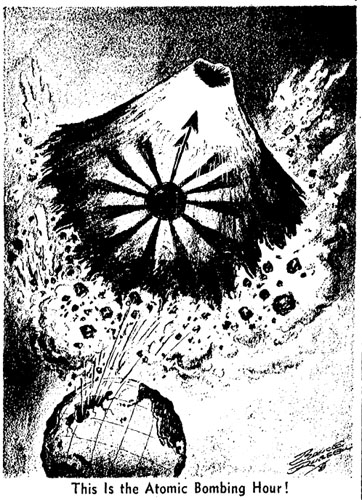
Los Angeles Times, August 7, 1945
This was the first one I found. Not a whole lot of content here other than the obvious excitement at the idea of a weapon of such tremendous power. Interesting that the clock motif dates from so early!
August 8
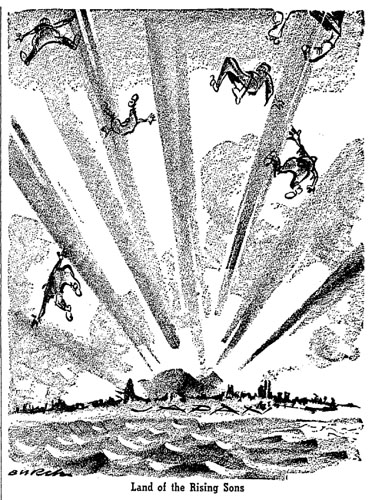
Atlanta Constitution, August 8, 1945
This one is fairly well-known — it makes quite a lot of light out of killing a lot of Japanese. Again, exhaultation and exuberance.
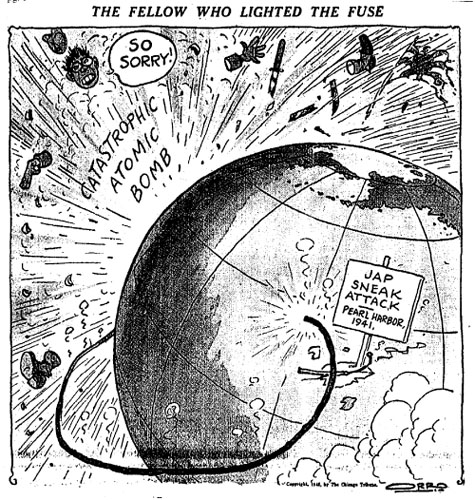
Chicago Tribune, August 8, 1945
The Chicago Tribune produced quite a number of these cartoons, and theirs were often pretty explicitly racist. This one also goes a bit beyond the other two so far in that it’s actually making an argument: the bombs were justified because of Pearl Harbor. To consider the bombs in need of justification of this sort, even at this early stage, is a nice sign of the aforementioned ambivalence.
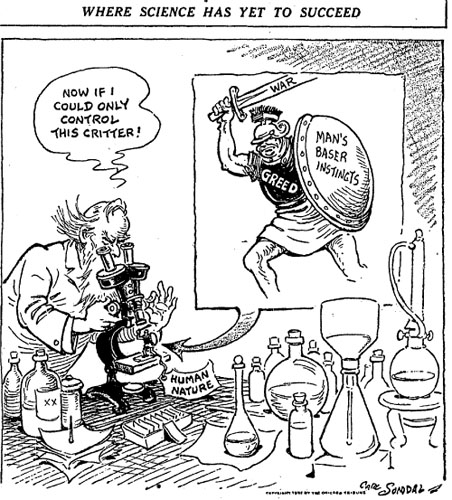
Chicago Tribune, August 8, 1945
Another from the Chicago Tribune, this one more explicitly ambivalent about what the bomb means for the future. Gotta love the depiction of the long-haired scientist…
August 9

Chicago Tribune, August 9, 1945
Hoo-boy — a lot of cultural baggage here! It’s easy to mock the “magic electron” bit, but more reflectively, it’s a sign at how brand-new the scientific terminology would have been to your average journalist, much less layperson. Some information on the science of the bomb had been released to the media this point in conjunction with the publicity efforts, but this is still well before the Smyth Report was released, so some scientific illiteracy isn’t too surprising.
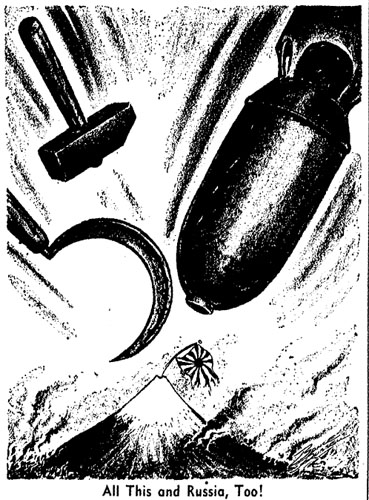
Los Angeles Times, August 9, 1945
The only cartoon I found which makes any reference to the Soviet invasion of Manchuria, which begun on August 9 (the same day as Nagasaki).
August 10

Los Angeles Times, August 10, 1945
Another exultant — and racist — cartoon.
August 11
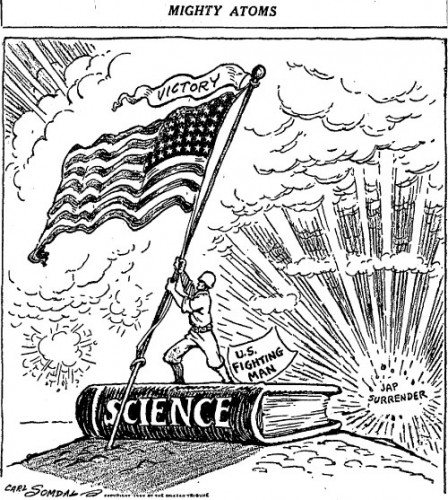
Chicago Tribune, August 11, 1945
Another science-themed cartoon (from the same artist as the earlier one), but this time a lot less ambivalent.
August 12, 1945

Chicago Tribune, August 12, 1945
Ah, now here’s some of the hard-core ambivalence setting in. Will the crater of the first atomic bomb be the grave of “warfare” or of “civilization”? Note this is the first one with any kind of mushroom cloud, as well. The Smyth Report had been made available to the press on the evening of August 11 (for release on August 12), so it’s possible that the author here had access to slightly more detailed materials on the subject than those previously.
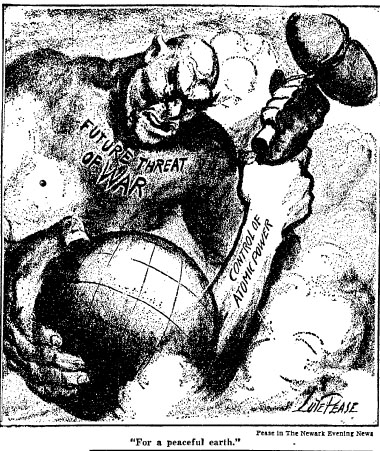
Newark Evening News, reprinted in the New York Times, August 12, 1945
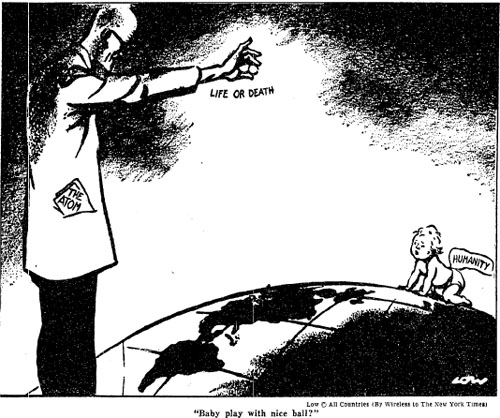
New York Times, August 12, 1945
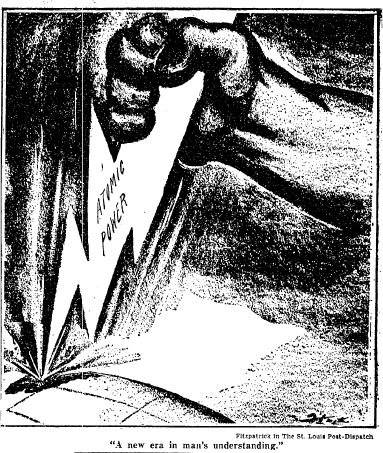
St. Louis Post-Dispatch, reprinted in the New York Times, August 12, 1945
On August 12, the New York Times print three comics on the subject of the bomb, at least two of which were originally printed elsewhere. The first is mostly positive — the atom will end war. The second is far ambivalent — humanity is but an infant preparing to play with life and death. And the third is, in my reading anyway, hard to parse. Is the new era a good thing? I’m not really sure how to interpret a giant hand jamming a lightning bolts into the planet — a good thing? A bad thing? A very awkward metaphor?
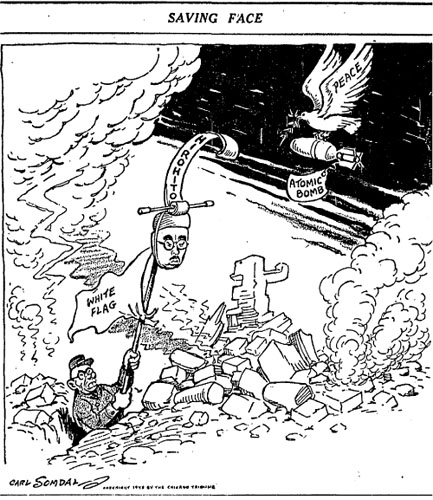
Chicago Tribune, August 12, 1945
This one is just… very odd. I guess it is supposed to be the Japanese Army using Hirohito as its face-saving surrender, because of the bomb? Hm. Not exactly a well-executed message in my view. But check out that dove with an atom bomb strapped to it:
That’s wild.
August 13
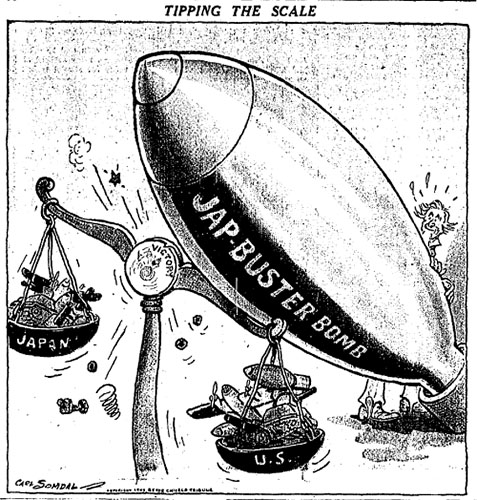
Chicago Tribune, August 13, 1945
One thing to note with both this and the most recent comic is their confidence that the war would be ending soon. This was still a few days before the Japanese capitulation — which was not entirely expected. One wonders how the view of the bomb would have changed if Japan hadn’t surrendered and the invasion had begun as planned.
August 14
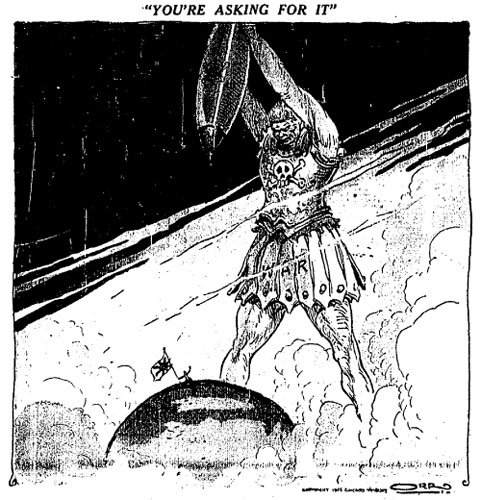
Chicago Tribune, August 14, 1945
Another justifying cartoon from the Chicago Tribune. I’ve gotta say — I feel a little sorry for Japan in this one. I think the cartoon unintentionally makes them look like the underdogs.
There are a few more in here that I’m skipping, just for space and because they weren’t that interesting. The next one sums up the message of quite a few of them:
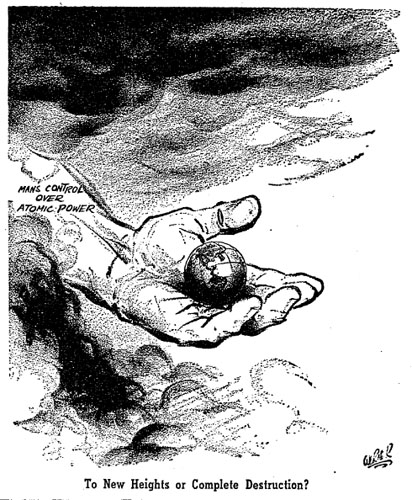
Atlanta Constitution, August 20, 1945
Now we’ve really entered into the hand-wringing, what-about-the-UN, can-we-have-atomic-peace stage of things. Clichés abound.
And thus we slide — from the exultation of the bomb towards the “what next?” phase of things. The connection between the explicit racism and the heavy exultation isn’t one that I’d really noticed quite so vividly before — it’s the sort of thing that might be read between the lines of written articles or editorials, but becomes quite obvious when it is being illustrated.
I want to add just one more cartoon here — one which is only tangentially related to the bomb:
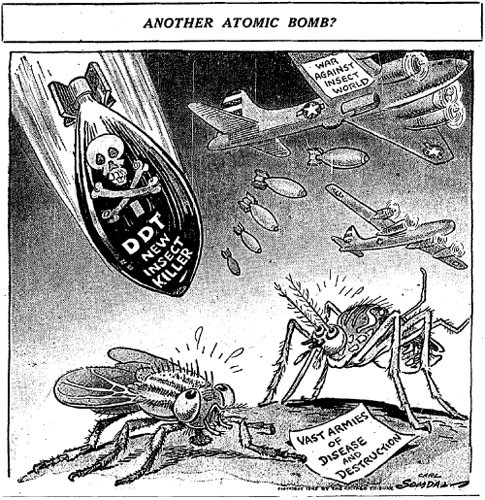
Chicago Tribune, August 24, 1945
One could make the argument that this connection between pesticides and WMDs is non-coincidental (the connection between chemical warfare and pesticides is pretty clear-cut), but what I find striking about this particular cartoon is the fact that in many ways it is deeper than it intended to be. Just like the atomic bomb, DDT was initially celebrated by many (most?) — but we’ve now replaced that excitation with at the very least ambivalence, if not abhorrence.
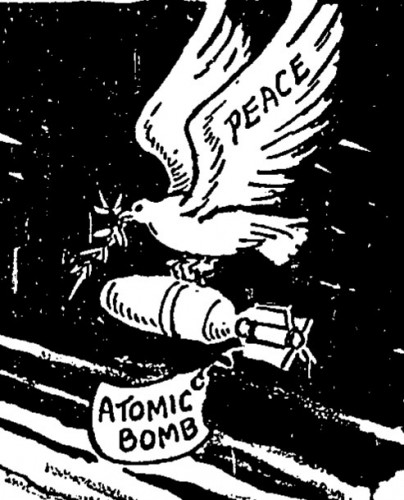


great post, Alex.
in my formative years, nobody put a more perfect ‘face’ on the Bomb than Herblock in the Washington Post.
Thanks, Michael. I agree about Herblock. When compared with some of the hacks above, his intellectual and visual subtlety was quite superior.
Really interesting post. One of my favorite blogs. Thanks for fixing the RSS feed! 🙂
Thanks! One of the posts from the last month or so somehow was being served up incorrectly which led to the RSS feed not validating, which apparently broke it for some browsers (Firefox, I’m looking at you). Anyway, I eventually managed to figure out what was wrong and fix it.
[…] As I’ve mentioned previously, there was a tremendous mixing of exaltation and anxiety that first week of the bomb. It wasn’t just one thing or the other; it wasn’t all positive. Looking at these front pages, you see a real mixture of expressions, and a real diversity of types of coverage, even given the limitations imposed by secrecy. For some, the story is the secrecy itself — for others, the bomb gets mixed into an existing narrative about firebombing. Out of the mixture of these narratives, our “standard narrative” of the history of bomb is derived. But it’s all too easy to turn that into a condensed, one-size-fits-all assessment of how Americans thought about the atomic bombs, when there was quite a diversity of opinion and expression, even from the start. Share/Bookmark […]
[…] were arguing loudly about this almost immediately. The ambivalence about the use of the bomb was nearly immediate, and even the Japanese were aware of such discussions taking place in the United States a month […]